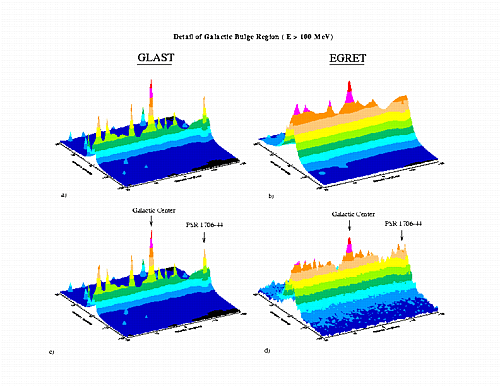We present here the components of a program which address the scientific goals discussed in section 2. The program requires a broad range of missions from suborbital balloon flights to intermediate class missions, in addition to an active SR&T support base for technology development. While significant advance over the capabilities of current missions, CGRO and INTEGRAL, requires intermediate class missions, key contributions to the understanding of gamma ray bursts and surveying the hard X-ray sky can be achieved in the context of the MIDEX program.

Figure 4.1 - Simulation of the galactic plane as it would be seen by the proposed GLAST instrument.
4.1 INTERMEDIATE CLASS
4.1.1 HIGH-ENERGY
EGREThas provided important discoveries of gamma-ray emission from a diverse population of astrophysical sources. However, our understanding of the gamma-ray emission mechanisms operating in these sources is limited by current instrumental capabilities. A future high-energy gamma-ray mission should provide an imaging, wide field-of-view telescope that covers the energy range from approximately 10 MeV to more than 100 GeV. In this energy range, gamma-rays are identified by recording the characteristic track signature of the electron-positron pair that results from pair conversion in the presence of a nucleus. The telescope consists of interleaved thin converters (metal foils) and position sensitive charged particle detectors followed by a calorimeter for energy measurement. Finally, the telescope requires a very efficient anticoincidence system for rejecting the much higher flux of background particles and an on-board trigger and data acquisition system. Modern particle tracking detectors (silicon microstrip detectors for example), sophisticated on-board processing, and higher telemetry rates will allow the required major advance in observational capability over EGRET within the constraints of an intermediate class astrophysics mission.